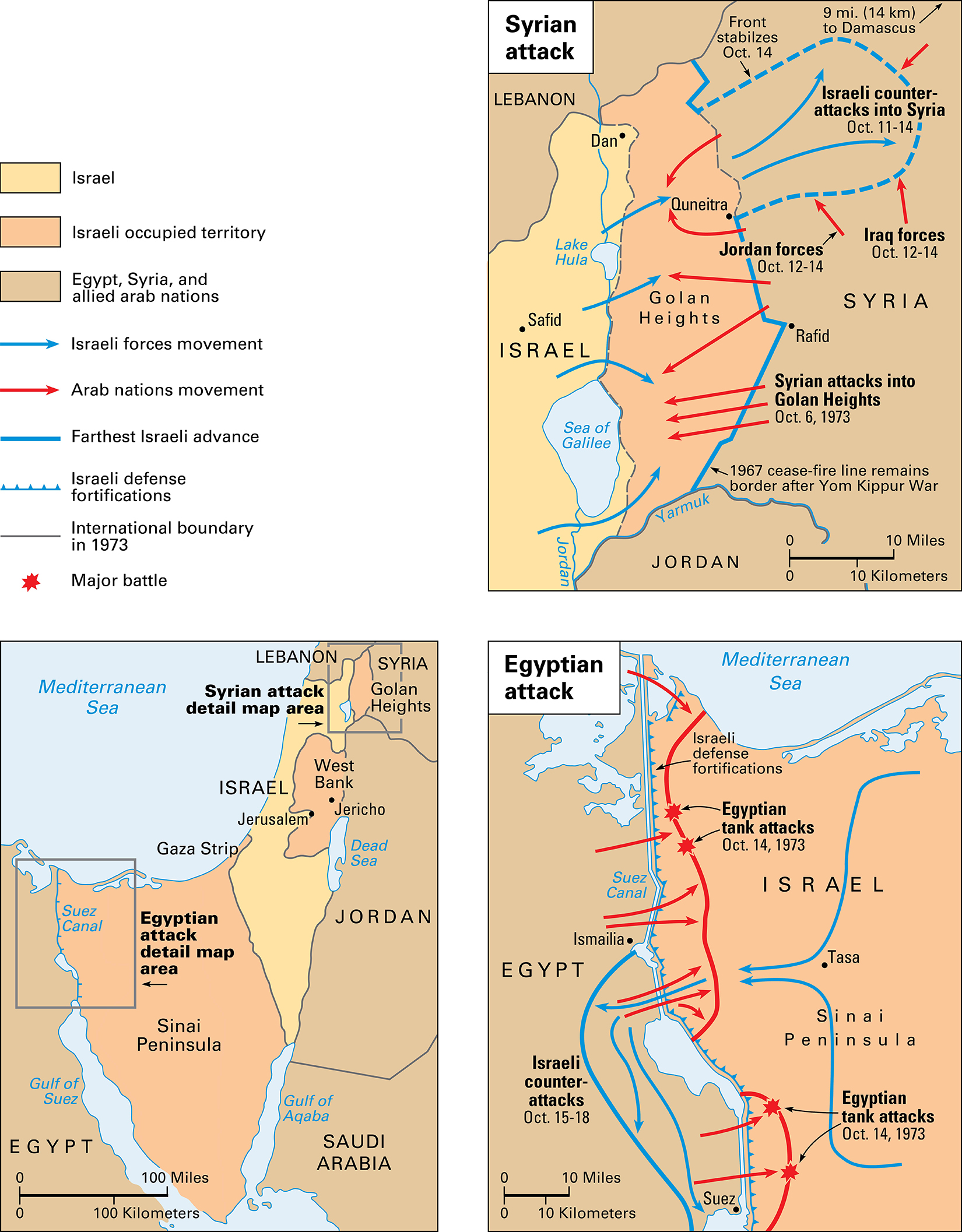Yom Kippur War was a 1973 clash between Israel and the Arab countries of Egypt and Syria. The fighting took place from October 6 to October 24. The first day of fighting was Yom Kippur, the most important Jewish holy day. The conflict also took place during the Islamic holy month of Ramadan. The Yom Kippur War ended in a stalemate, but it changed Arab-Israeli relations in the Middle East . The conflict led to the Camp David Accords, a set of landmark agreements between Egypt and Israel. The Yom Kippur War is sometimes called the Ramadan War, the October War, or the Arab-Israeli War of 1973. Iraq, Jordan, and other Arab nations played small roles in the conflict.
Background.
The Yom Kippur War was the fourth major Arab-Israeli conflict after the nation of Israel was established in 1948. In the 1967 Six-Day War , Israeli forces defeated an Arab force led by Egypt, Jordan, and Syria. As a result, Israel took possession of bordering territories: Jordan’s West Bank, Syria’s Golan Heights, and Egypt’s Gaza Strip and Sinai Peninsula. After the war, Egypt and Syria still refused to accept Israel’s existence. They also demanded that Israel return the territories it gained in the war. Israel refused, and Egypt and Syria again prepared for war.

The Suez Canal separates mainland Egypt from the Sinai Peninsula. After the 1967 war, Israel built strong defenses east of the canal. In the autumn of 1973, Egypt had about 600,000 active troops, 2,200 tanks, and 550 aircraft. Many thousands of Egyptian troops secretly massed on the canal’s west bank. At the same time, Syria gathered 1,400 tanks and about 120,000 troops near the Golan Heights. Intent on recovering lost land, Egypt and Syria chose the combined holidays of Yom Kippur and Ramadan to launch simultaneous attacks.
Israel’s forces included some 350,000 troops, 2,000 tanks, and 480 warplanes. However, only a few thousand troops were on active duty in the Sinai or near the Golan Heights. After fighting began, Israel had to quickly call up reserves, dividing them between the two fronts. The Israelis were outnumbered, but they were better equipped, trained, and coordinated.
The Egyptian attack.
On Oct. 6, 1973, Egyptian forces attacked Israeli defenses east of the Suez Canal. Israeli defenders, surprised and outnumbered, were overrun or surrounded. The Egyptians then pressed forward against Israeli counterattacks. After days of bloody fighting for limited gains, the Egyptian advance stopped.
On October 14, Israeli forces drove back a massive Egyptian tank attack. Some 250 Egyptian tanks were destroyed. Israeli forces counterattacked, dividing the Egyptian forces. Israeli troops crossed the Suez Canal and advanced into Egypt. After bitter fighting farther north, Israeli troops also regained much of the area lost days earlier.
The United Nations (UN) arranged a cease-fire on October 22, but fighting between the two nations continued. The two sides officially obeyed a second UN cease-fire on October 24. Occasional fighting continued, however, until an armistice (agreement to end fighting) was signed in January 1974.
The Syrian attack.
Also on Oct. 6, 1973, Syrian forces attacked Israeli defenses in the Golan Heights. The outnumbered Israeli troops initially fell back. But after quick reinforcement, the Israelis stopped the Syrian advance. At great cost to both sides, Israeli forces then drove the Syrians from the Golan Heights and advanced into Syria. Aided by Iraqi and Jordanian troops, the Syrians finally stopped the Israelis about 25 miles (40 kilometers) from Damascus, the Syrian capital.
The first UN cease-fire on October 22 largely ended the fighting in Syria. As in Egypt, however, occasional violence continued for months. Israel and Syria agreed to an armistice on May 31, 1974.
Aftermath.
More than 2,500 Israeli soldiers died in the Yom Kippur War, and more than 7,000 were wounded. Combined Arab casualties (people killed, wounded, missing, or captured) surpassed 50,000, including some 12,000 to 15,000 dead.
Renewed peace efforts in the Middle East led to the Camp David Accords of 1978. Under these agreements, Egypt recognized Israel’s right to exist. In return, Israel agreed to leave the Sinai Peninsula.
